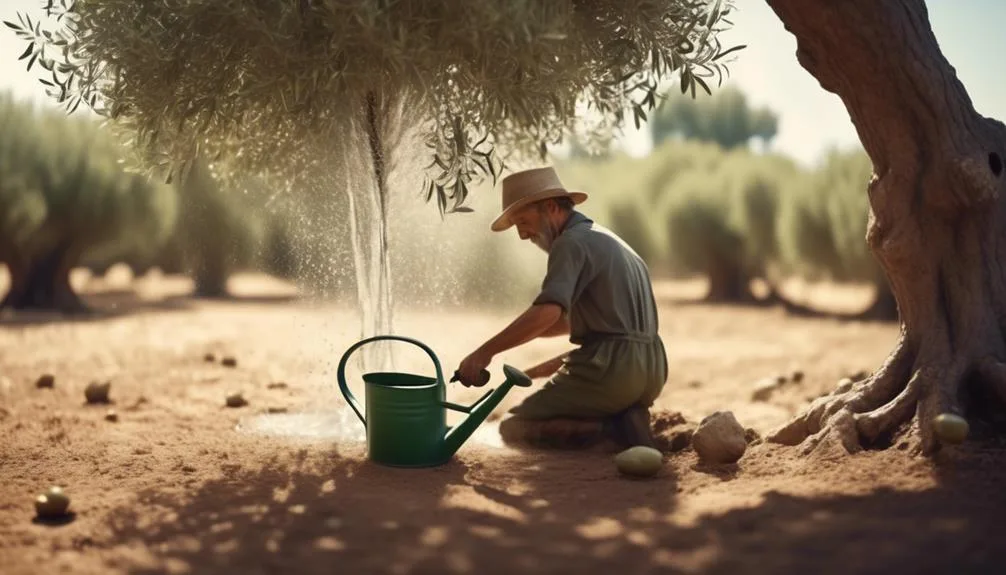Properly watering your olive trees is crucial for their health and productivity. Understanding their water needs and knowing when and how often to water them can make a big difference.
If you want your olive trees to thrive and produce the best harvest, there are important steps to follow. This article will cover the essential techniques and considerations for watering your olive trees effectively.
Key Takeaways
- Deep watering promotes strong and stable root growth in olive trees.
- Olive trees require well-drained soil and watering should be done when the top 2-3 inches of soil are dry.
- Signs of underwatering include dry soil, drooping and wilted leaves, while overwatering is indicated by waterlogged soil and leaf discoloration.
- Watering should be done in the early morning, using proper irrigation techniques such as drip irrigation, to encourage deep root growth and prevent fungal diseases.
Best Watering Practices for Olive Trees
To ensure the health and vigor of your olive trees, it's essential to follow best watering practices that promote deep root growth and efficient water usage.
Deep watering is key to encouraging the roots to grow downward, creating a strong and stable foundation for the tree. When you water, make sure to saturate the soil to a depth of at least 12 inches, allowing the water to penetrate deeply. This helps the roots to access water from lower soil layers, promoting their development and making the tree more resilient to drought.
By contrast, shallow watering leads to surface moisture, which encourages shallow root growth and makes the tree more susceptible to dry conditions.
Deep watering fosters a robust root system, ensuring that your olive tree can thrive even in challenging environmental conditions.
Understanding Olive Tree Watering Needs
Understanding the watering needs of olive trees is crucial for ensuring their health and resilience, as well as maximizing their productivity.
Olive trees require well-drained soil to prevent waterlogged conditions that can lead to root rot.
It's important to understand soil moisture levels to determine the optimal hydration techniques for your olive trees. Before watering, check the soil moisture by sticking your finger into the soil. If the top 2-3 inches of soil are dry, it's time to water.
When watering, do so deeply but infrequently to encourage deep root growth. This can be achieved by applying water slowly to allow for deep penetration.
Additionally, consider using a soaker hose or drip irrigation system to deliver water directly to the base of the tree, minimizing water waste.
Understanding these factors will help you meet your olive tree's watering needs effectively.
Signs of Underwatering and Overwatering Olive Trees
Checking for signs of underwatering or overwatering in your olive trees is a crucial part of maintaining their health and productivity. One clear indicator of underwatering is dry soil. Olive trees prefer well-draining soil, but if the soil becomes excessively dry, it may indicate insufficient water supply.
Another sign is leaf drooping. When olive trees lack water, their leaves may start to droop and appear wilted.
On the other hand, overwatering can lead to waterlogged soil. Excessive moisture can cause the roots to rot and compromise the tree's health. Overwatering may also result in leaf discoloration or yellowing.
Timing and Frequency of Watering Olive Trees
When watering olive trees, it's essential to consider the timing and frequency to ensure their optimal health and growth.
The timing of watering is crucial, especially during the growing season. Watering in the early morning allows the trees to absorb moisture before the heat of the day, while evening watering can lead to prolonged soil moisture, increasing the risk of fungal diseases.
The frequency of watering depends on various factors such as soil moisture and water retention. Olive trees prefer well-draining soil, so it's important to water deeply but infrequently to encourage deep root growth and enhance water retention.
Checking the soil moisture regularly can help determine the appropriate watering frequency.
Using Proper Irrigation Techniques for Olive Trees
To ensure the optimal health and growth of your olive trees, it is crucial to employ proper irrigation techniques that promote deep root growth and efficient water retention. One highly effective method for watering olive trees is drip irrigation. This system delivers water directly to the base of the tree, allowing for slow and consistent moisture penetration into the soil. Monitoring soil moisture levels is also essential for the proper care of your olive trees. By regularly checking the moisture content of the soil, you can ensure that your trees are receiving adequate hydration without risking waterlogging. Here's a table to highlight the benefits of drip irrigation:
| Benefits of Drip Irrigation |
|---|
| Conserves water |
| Reduces weed growth |
| Minimizes soil erosion |
| Prevents leaf wetting and disease |
Conclusion
Incorporating these watering practices will help your olive trees thrive, ensuring their health and productivity. By staying mindful of their watering needs, observing signs of overwatering and underwatering, and utilizing proper irrigation methods, you can support the well-being of your olive trees.
Remember to water deeply and infrequently, adjusting your schedule based on weather and soil conditions. With these strategies in place, your olive trees will continue to flourish and provide beauty and bounty for years to come.

